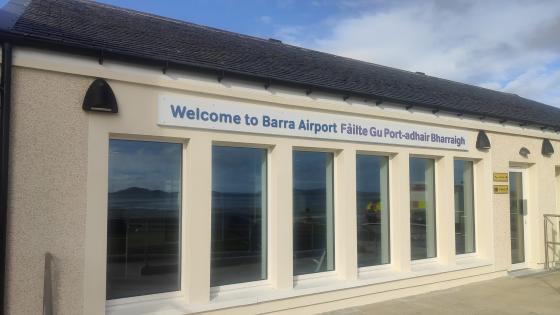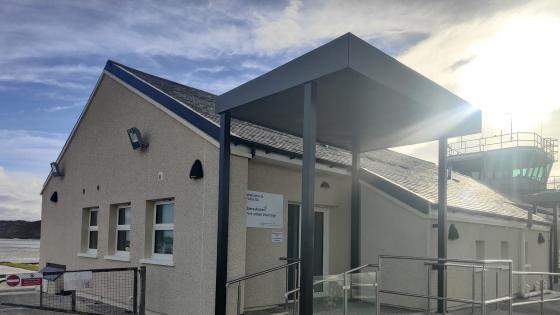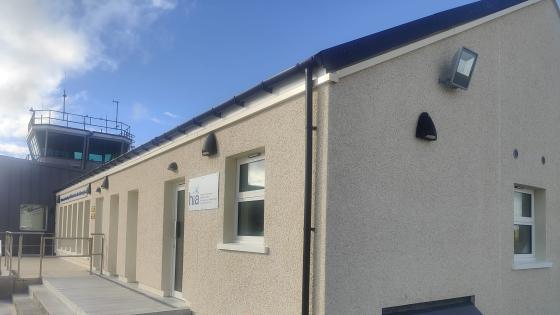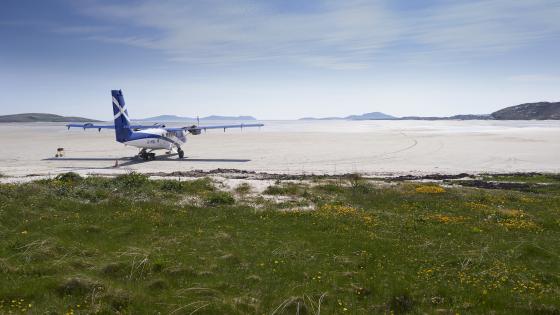Its remote location in the Outer Hebrides gives Barra Airport a certain windswept romance, but it also means that updating facilities requires ingenuity and skill
Like all the islands in Scotland’s Outer Hebrides, Barra boasts some of the UK’s most stunning scenery. Every year, hundreds of tourists flock to the island to enjoy its natural beauty and Neolithic remains, but also to experience something unique: landing in an aircraft on a beach.
Also known as Barra Eoligarry Airport, this is a short-runway airport (or STOLport) located on the wide shallow bay of Traigh Mhòr at the northern tip of the island. With just a control tower and a small terminal, it is the only airport in the world where scheduled flights land on a tidal beach. It operates with three runways arranged in a triangle, marked by wooden poles at their ends,in directions 07/25, 11/29 and 15/33.
At just 5ft above sea level, all three runways are completely submerged at high tide. They are meticulously managed to allow the DHC-6 Twin Otter – the primary aircraft serving the airport – to land into the wind. The airport’s schedule is governed by the ebb and flow of the tide. When it is closed and the windsocks are down, people are free to walk on the runways, which become once more a well-loved public beach.

Flights operate twice daily between Barra and Glasgow
Flights operate twice daily to and from Glasgow, with passenger numbers having almost doubled from 7,500 after the airport opened in the 1970s to 14,800 pre-COVID-19.
In 2011, Barra Airport was voted the world’s top airport approach in a global poll and 11 years later, in 2022, it topped Airways magazine’s poll of the world’s top six must-see runways. It provides lifeline services to the island’s 1,000 inhabitants. In recognition of this, the Scottish government has given these flights public service obligation (PSO) status and provides funding for them.
Breathing new life into Barra
The terminal building is set back from the beach, with a small car park for up to 80 vehicles, and staff welcome visitors from all across the globe.
To update and improve the comfort and efficiency of the original terminal, while also upgrading its café facilities, the Highlands and Islands Airports Limited Group (HIAL) – which is responsible for the management and operation of 11 regional airports, including Barra – recently invested approximately £1.5m in modernising the facility.
This involved not only internal work such as modernising fixtures and fittings and converting the existing appliance bay into a café and seating area, but also some external improvements. The outside area has been landscaped to include paving and decking in the surrounding area to improve accessibility and a new beach terrace has been added to enhance the outdoor space.
While the work was being carried out, the building was divided into two by a temporary partition so that the airport could remain operational throughout, causing minimal disruption to passengers.

Pebbledash is popular in exposed areas as it provides an extra layer of protection from the elements
Better thermal efficiency
To improve the thermal efficiency of the building, as well as increase protection in an area of high exposure, HIAL also specified an external wall insulation (EWI) system for its main building. Installing EWI is one way to significantly lower energy bills, which is especially beneficial as fuel costs remain high. It helps to address two of the most common issues that cause buildings to be less energy efficient: thermal bridging and air leakage.
Thermal bridges are weak points or areas within the building envelope which allow heat to pass through more easily. This gap within an insulation system creates a bridge between the outer and inner face of the building and can cause water and condensation to gather. According to the UK’s Building Research Establishment (BRE), this can result in up to 30% of heat loss. Meanwhile, air leakage occurs when air enters and leaves a building uncontrollably through cracks and holes. Applying an EWI system around the outside of the building provides a continuous layer of insulation, preventing gaps from forming and eliminating unwanted draughts.
EWI systems can also play a big role in keeping out external pollutants, thus improving air quality. By using breathable materials, water vapour can pass through, preventing any build-up of damp. What’s more, EWI increases the surface temperature of the walls, thus reducing the temperature difference between the internal and external walls, meaning less condensation should settle. As mould is caused by damp, minimising the moisture inside will help combat its spread.
Another benefit of installing EWI on existing buildings such as the Barra terminal is that it extends their life by keeping the old structure warm and stable. It also offers the opportunity to protect, enhance and repair old façades, using a combination of thermal, decorative and structural elements.

Barra Airport consists of a control tower and a small terminal
Selecting a quality solution
For the EWI at Barra Airport, the main contractor was Benbecula-based MacInnes Bros, which specified Saint-Gobain Weber’s webertherm XP system. Working closely with the MacInnes team, Weber’s specification manager, John McGinley, recommended Matthew McDougall from Pristine Plasterers as the applicator.
McDougall, who is based outside Glasgow but happily travels to the Western Isles for work, is very familiar with Weber products, having used them for a number of years. He went through a thorough vetting process to become a Weber-recommended applicator, to ensure he follows the strict specification and carries out the work to the required standard.
The system fitted to Barra was made up of 100mm of webertherm MFD (mineral fibre) insulation boards, which are not only non-combustible but also contributes to sound reduction across the façade, something which is especially welcome at an airport. One of the key benefits of the application of the webertherm XP EWI system is that it is fast and economical. There is no need to wait for a base coat to dry as only one coat of render in two passes is required. At Barra, a one-coat, through-coloured mineral render – webertherm M1 in Cornish shade – was applied using pump delivery. It was then finished with a beige marble pebbledash to ensure the exterior looked as it had done previously and remained in keeping with the surrounding area.
“Generally, many projects tend to be specified with a thin coat render to achieve a smooth modern finish,” said McGinley. “But in Scotland and most of the west coast, the pebbledash finish is popular in exposed areas such as the Isle of Barra as it provides an extra layer of protection from the elements.”
Thickness requirements are impacted by location, orientation and exposure to wind and rain. The recommended thickness for sheltered to moderate exposure is 15mm. In more severe environments, such as coastal properties, this increases to 20mm.

Working in such a remote location requires detailed planning
Working remotely
One of the main challenges of working in the Outer Hebrides is the logistics, as it can be difficult to transport goods to the islands. To help with this, each week Weber makes a ‘milk run’, whereby products are delivered to the North Coast of Scotland. From there, the main contractor is usually responsible for getting them to the relevant island.
Reflecting on the work done at Barra Airport, McGinley told Airports International: “It’s not every day you get to work on such a unique project. Thankfully, Matthew was lucky with the weather, as it remained pleasant throughout the application, meaning there were no hold-ups due to Mother Nature.”
The EWI installation at Barra was completed in August 2023.

Barra is the only airport in the world where scheduled flights use a tidal beach as the runway
